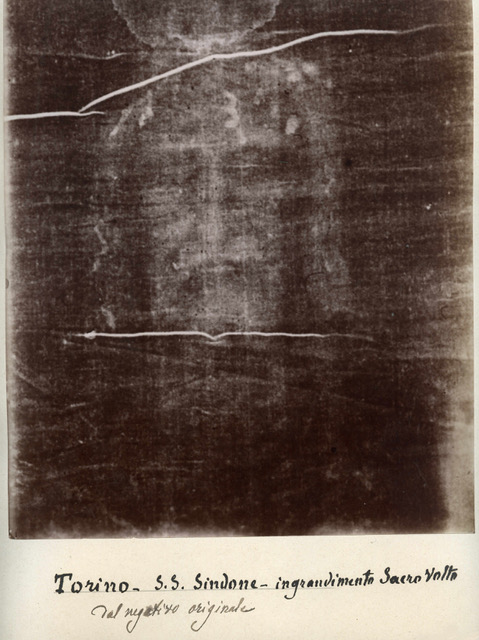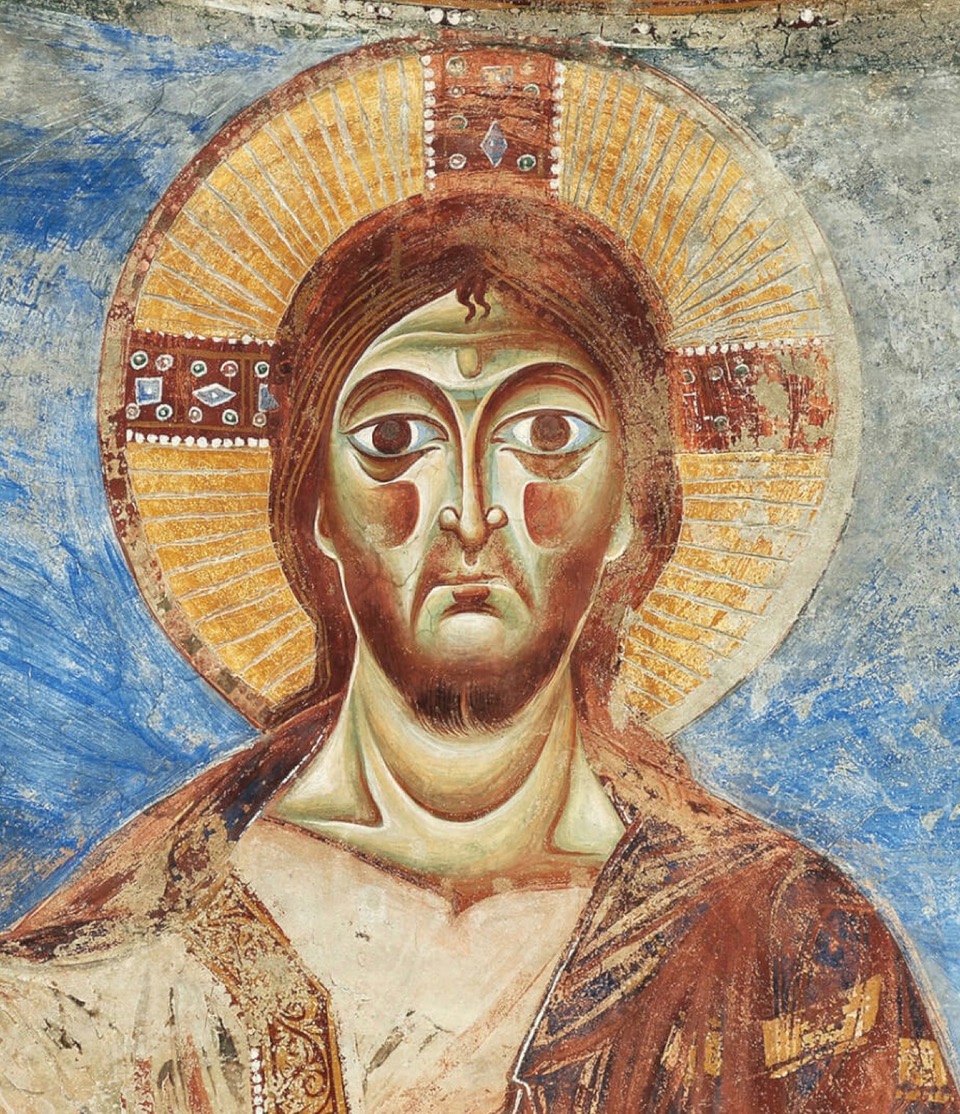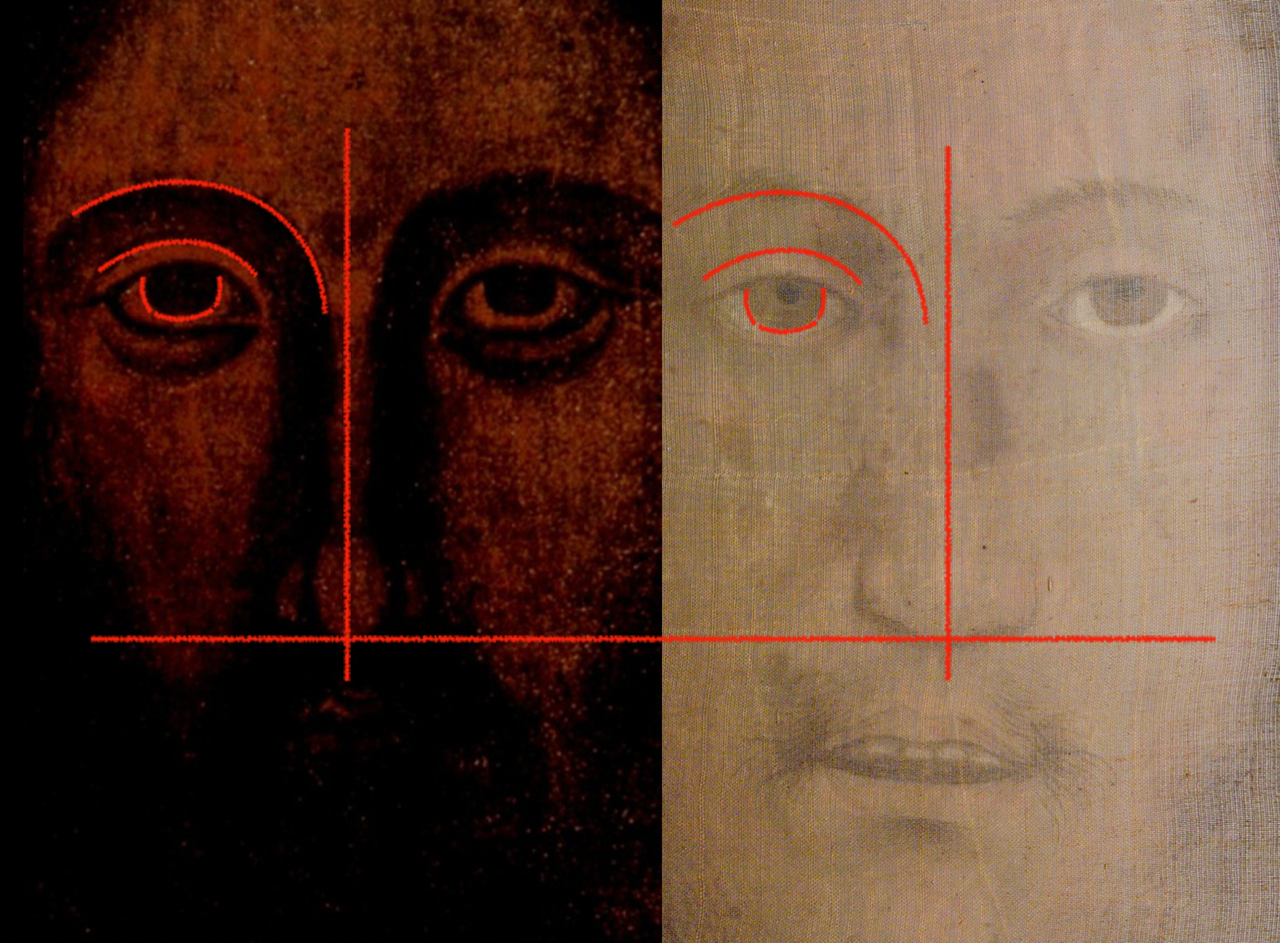The Shroud as a Prototype for the Depiction of Jesus
Zbigniew Treppa ![]()
University of Gdansk, Poland
In Christian iconography, there are various canons of depicting the image of Christ. It was not until the late 1930s that the origins of the images of Christ began to be scientifically clarified. In 1902, the French scholar Paul Vignon, in his work Le Linceul du Christ, presented the results of research that showed a strong resemblance between the face of Christ from the Shroud and images of him made in the period before the Shroud appeared in Europe. P. Vignon presented a list of icons which, in his opinion, could have been modelled on the image that appears on the Shroud. These included late medieval mosaic images of Christ from Palermo Cathedral or sculptural representations from Chartres Cathedral.
Popular science literature and journalism began to spread the information that the image of the figure from the Shroud provided a model for medieval images of Christ. This was due to P. Vignon’s comparative studies, which showed formal dependencies of certain images of Christ on the image appearing on the Shroud, both in Eastern and Western iconography. The French scholar was convinced that the results of his research indicated that the image from the Shroud had become the prototype of images depicting Christ and representative of different schools. P. Vignon’s research was the first to compare the image visible on the Shroud with medieval representations of Christ.
P. Vignon undertook his research after seeing photographs of the Shroud taken by Secondo Pia in 1898. The fact that Pia’s photograph showed the image of the body on the Shroud like a photographic negative changed the perception of the cloth among some scholars. Before Pia published his discovery, the Shroud was considered almost exclusively as yet another Christian relic. After the publication of the aforementioned reproduction, it also began to be seen as an object that could be subjected to scientific study, in the same way as archaeological objects, for example. It was not until the photographic positive of the image from the Shroud was obtained by tonal transformation of the original image that the similarity of the facial features from the Shroud to the various iconic representations depicting Christ could be discerned and thus made it possible to undertake scientific reflection on these similarities.

Before undertaking his comparative research, P. Vignon analysed the structure of the body image from the Shroud, in which he also proved to be a pioneer. He was the first to observe that, where the Shroud adhered to the surface of the body, the clarity of the image was greater than where the cloth was not in contact with the body. P. Vignon attributed the difference in clarity to the action of ammonia vapours: these vapours would have emanated from the urea found in the blood and sweat of the Shrouded Man and settled on the aloe-covered linen, in an amount inversely proportional to the distance between the cloth and the body wrapped in it. This was the first scientific attempt to explain the phenomenon of different image clarity observed by the Frenchman. It has not stood the test of time. Analyses of the image over the last few decades have also shown that P. Vignon was wrong on a number of issues concerning the dependence of the aesthetic canon of medieval images of Christ on the image from the Shroud. However, this does not diminish the importance of his discovery. He remains the first scholar to direct researchers’ attention to questions concerning the dependence of Christ images on some prototypical image.
P. Vignon made the mistake of failing to consider another object that could be a source for the images of Christ. It is the →Veil of Manoppello which bears an image of Christ with the same facial proportions as the one from the Shroud, which was confirmed scientifically only in the last decades of the 20th century. Unfortunately, from the beginning of the 20th century, when P. Vignon conducted his research on the Shroud, until the 1970s the Veil of Manoppello was completely unknown among the scholars studying the Shroud. It was for this reason that the results of his analyses were accepted as reliable. This, however, caused researchers to draw erroneous conclusions, even as late as the turn of the 20th century, when scientific studies on the influence of the Veil of Manoppello on the development of the canons of images of Christ, those from the Middle Ages and those from antiquity, were already known. These researchers include Yves Bongert, Pierluigi Baima Bollone and Mario Moroni. Taking into account the results of P. Vignon’s research, they misinterpreted, for example, the blood spill in the shape of the Greek letter epsilon (ε) visible on the forehead of the image of Jesus from the Shroud as the origin of the characteristic strand of hair on the forehead seen on many iconic representations of Christ’s face.
This error was due to the fact that the colouring of blood on the Shroud is very distinctive and therefore it is difficult to assume that the icon writers would not have been able to distinguish between the red blood trail clearly visible on the cloth and the image of a body with a delicate straw-sepia colouring, all the more so if they were able to see barely visible details in the image from the Shroud, such as the shape of the hair or the beard. It is not difficult for an outsider to distinguish traces of blood from the arrangement of the hair; therefore, the authors of the icons—careful observers of the image from the Shroud, the authors who intended to faithfully render the details of the face—could not mistake it for an image of the body (Andreas Resch CSsR, Heinrich Pfeiffer SJ, K. Aszyk, Z. Treppa). Both P. Vignon and, years later, Y. Bongert, P.B. Bollone and M. Moroni in their conclusions on the influence of the image from the Shroud on the development of the medieval canons of depicting Christ also failed to take into account how icon painters could analyse the details of the image from the Shroud at a time when it was only possible to look at the negative of the image. It was not possible for icon painters to obtain such precise data or thus to produce such a detailed portrait, in any case not before 1898, when only the negative of the image was known (Resch 2006).
Before 1898, many details of the image from the Shroud could not be observed. This was due not only to the fact that the original image was a negative, but also to the fact that the outline of the face is not clear, to the fact that the image, observed from a short distance, fades away, blending into the background. A more accurate image is only provided by a photograph taken with a long-focus lens, which allows snapshots to be taken from greater distances. One of the most ardent supporters of P. Vignon was Ian Wilson, who in several of his publications promoted his theory regarding the dependence of representations of Christ on the image from the Shroud. Wilson, being a historian, did not use the research tools of image analysis in his work, which led him to approach the concept uncritically, relying on the scientific authority of Yves Delage, who in turn was a biologist and therefore also not a specialist in image analysis. In journalism and popular science studies, P. Vignon’s concept is still erroneously regarded as credible, and this is mainly due to ignorance of the influence of the image from the Veil of Manoppello on the development of the medieval iconographic canons of Christ’s face.
The research carried out on the relic from Manoppello supports the idea that the prototype of many iconic representations of Christ’s face is precisely this relic and not the Shroud of Turin. If I. Wilson, in his book The Blood and the Shroud: New Evidence That the World’s Most Sacred Relic is Real? was able to conclude that, for example, that the image of Christ on the Byzantine coin of Emperor Justinian II is bearing a close resemblance to the facial area on the Shroud, it should also be noted that the depiction on this coin bears a much greater resemblance to the image from the Veil of Manoppello, as indicated, for example, by the pronounced form of the arches of the eyebrows and the two strands of hair, both very similar in form to that featured in the Veil image.
Both these elements are absent from the image from the Shroud. Similar conclusions can be drawn with regard to other examples cited by I. Wilson, supposedly derived from inspiration by the image from the Shroud, namely the image of Christ Pantocrator (c. 1000) from the Basilica of Sant’Angelo in the Abbey of Formis in Italy and the image of Christ Pantocrator (c. 600) appearing on a silver vase found in Homs, Syria. In both cases, the features of the images clearly relate to the image from the Veil of Manoppello. According to A. Resch and H. Pfeiffer, the image from the fabric of Manoppello became the model for the icons of Christ much earlier than the image from the Shroud could have done.

There are many representations of Christ dating from late antiquity and the early Middle Ages which could not have been created under the observation of the image from the Shroud, if only because the shape of the pupils and some anatomical details of the face cannot be observed on them, which for obvious reasons cannot be seen on the image from the Shroud. An example of this is the Volto Santo from Constantinople (given as a gift to Leonardo Montald, governor of the Genoese colony on the Bosporus, by the Byzantine emperor John V), which has been kept in Genoa in the church of San Bartolomeo degli Armeni since 1384. Hans Belting, a painting anthropologist, characterising this monument together with the closely related Vatican panel (looted from Constantinople by the Venetians in 1204), speaks of them as paintings with a striking archaism and characteristics found in East Syrian works from the 3rd century (both are tempera paintings on linen canvas, and both are pasted on cedar board of the same format) (Belting 2010).
This researcher’s description of the way the eyes on the Volto Santo of Genoa were painted is very significant: the linear encirclement of the eyes already betrays the hallmarks of a medieval replica. However, the type under scrutiny departs from any conventions of Christ at the time (Belting 2010). The oval shape of the irises from the Volto Santo of Genoa is identical to those of the image from the Veil of Manoppello, whereas later icon painters usually reproduced the shape of the irises in circular form (see →The Shroud and the Convention of the Mandylion).

However, the Shroud of Turin clearly influenced the development of many depictions of Christ, above all those derived from the Byzantine tradition of the Imago Pietatis canon (see →The Shroud and the Imago Pietatis), in which it seems that two traditions of depicting images of Christ may meet. One is inspired by the image with closed eyes from the Turin Shroud, which is evidenced by, among other things, the way in which the figure is situated, imitating the position of the body on the Shroud (the arrangement of the hands from the Imago Pietatis representations imitates the arrangement of the hands from the Shroud), and the other may be inspired by the image from the Veil of Manoppello, which is confirmed by clear references in many realisations of this canon to the proportions and expression of the face from the Veil.

As the American sindonologist John P. Jackson proved in the late 1970s (as published in numerous studies of the Shroud of Turin and repeated at the Interdisciplinary International Conference on the Acheiropoietos Images in Toruń in 2011), the Imago Pietatis canon was formed largely under the influence of a very specific public presentation of the Shroud.
The image of the whole body from the Turin cloth, rather than being confined to the area of the face or bust, must in a somewhat similar way have influenced the formation of the convention of showing the figure of Christ on the →epitaphios, an important Orthodox liturgical object used during the all-night vigil preceding Resurrection Sunday. The two images—from the Shroud and from the Veil—had, in different ways, a significant influence on the formation of another Byzantine canon of depicting the image of Christ—the mandylion (see →The Shroud and the Convention of the Mandylion). In the Church of Rome tradition, this in turn evolved into the iconographic convention of the Veil of St Veronica. It cannot be ruled out that some frontal depictions of Christ, which may have been at the origin of the mandylion convention, were inspired by both images—both from the Shroud and from the Veil—since they happen to contain formal elements that may result from the observation of both relics. In many cases, however, it is impossible to say unequivocally which of the two images may have been the prototype for the frontal representations of Christ.
References
Aszyk K., Can an Acheiropoietos Icon be Considered in the Category of the Signs of the Times?, paper delivered at Interdisciplinary International Conference on the Acheiropoietos Images, Toruń 2011.
Aszyk K., Napięcia pomiędzy ciałem pogrzebanym a zmartwychwstałym – kryteria uznania wizerunku za “acheiropoietos” na przykładzie Chusty z Manoppello, paper delivered at the seminar “Teologia wizualna w ciele”, Warszawa 2012.
Aszyk K., Treppa Z., Ikona z Manoppello prototypem wizerunków Chrystusa, Gdańsk 2012.
Aszyk K., Treppa Z., The Manoppello Icon: The Prototype of Images of Christ, Gdańsk 2014.
Balossino N., Wizerunek na Całunie. Analiza fotograficzna i informatyczna, Warszawa 1998.
Belting H., Obraz i kult. Historia obrazu przed epoką sztuki, przeł. T. Zatorski, Gdańsk 2010.
Bollone P.B., Całun Turyński. 101 pytań i odpowiedzi, przekł. K. Stopa, Kraków 2002.
Bongert Y., L’iconographie du Christ et le Linceul de Turin, [in:] L’identification scientifique de l’homme du linceul Jésus de Nazareth : actes du symposium scientifique international, Rome [10, 11 et 12 juin] 1993, éd. A.-A. Upinsky, Paris 1995.
Bulst W., Pfeiffer H., Das Turiner Grabtuch und das Christusbild, Bd. 1: Das Grabtuch. Forschungsberichte und Untersuchungen, Frankfurt am Main 1987.
Moretto G., Całun. Przewodnik, Warszawa 1998.
Resch A., Der Schleier von Manoppello und das Grabtuch von Turin, Innsbruck 1999.
Resch A., Das Antlitz Christi. Grabtuch, Innsbruck 2005.
Resch A., Oblicze Chrystusa. Od Całunu Turyńskiego do Chusty z Manoppello, tłum. A. Kuć, Radom 2006.
Vignon P., The Shroud of Christ, Westminster 1902, [on-line:] https://archive.org/details/TheShroudOfChrist/page/n11/mode/2up?view=theater – 12 III 2022.
Vignon P., Le Saint-Suaire de Turin devant la science, l’archéologie, l’histoire, l’iconographie, la logique, Paris 1938.
Wilson I., The Shroud of Turin: The Burial Cloth of Jesus Christ?, Garden City 1978.
Wilson I., Krew i Całun. Czy Całun Turyński spowijał ciało Chrystusa?, Warszawa 2001.
Sources of Images
1. Collection and ownership of the Polish Syndonological Centre in Kraków
2. Wikimedia Commons, https://commons.wikimedia.org/wiki/File:Abbazia_di_Sant’Angelo_in_Formis,_Cristo_Pantocratore.jpg (Mongolo1984, CC BY-SA 4.0)
3. and 4. Collection of Z. Treppa
